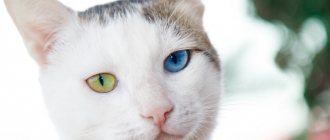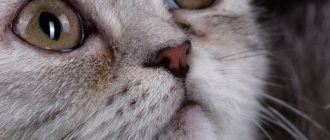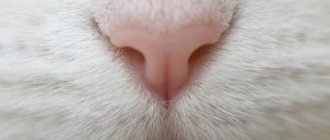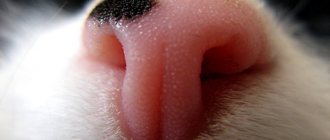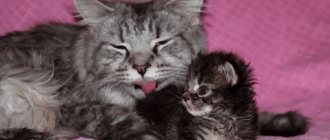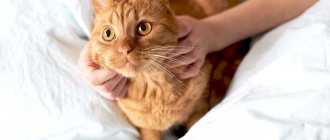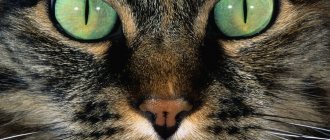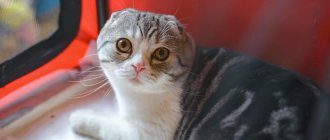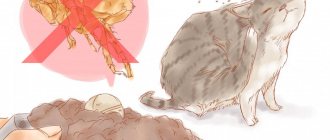Normally, a cat's feces are dark brown, well-formed, and look like a smooth sausage without foreign inclusions. But sometimes the color of stool for some reason becomes too dark or light, foul-smelling, liquid or hard. In such a situation, you should monitor the pet’s behavior, because often suspicious feces indicate the occurrence of a dangerous disease in the body, which cannot be started.
What's the normal color?
Feces in cats, like in humans, can tell everything about their health. The cat poops in dense, well-formed masses that are brown or dark brown in color. The consistency of excrement depends on the content of liquid, fat, and mucous components. The smell of feces is not unpleasant, not strong, this smell is called feces. If the diet is dominated by dairy and fermented milk products, cereals, and vegetables, the mass acquires a light brown tint. When a pet eats mainly meat, the excrement becomes a more saturated dark color.
Associated symptoms of diarrhea in cats
In addition to loose green stools, the following symptoms may indicate diarrhea::
- Increased body temperature.
- Change in animal behavior.
- The cat is thirsty all the time.
- The pet's body weight decreases.
- The quality of the cat's fur becomes poor.
- The mucous membranes of the animal turn pale.
- Appetite disappears.
© shutterstock
Green stool in a kitten with a liquid consistency, turning into a chronic condition, leads to dehydration of the animal’s body and the accumulation of toxins in it. In this case, metabolic processes are disrupted. The kitten's growth and development slow down.
Reasons for changes
If the color is dark
Very dark, almost black stool with an unpleasant odor indicates digestive problems. If food is not fully digested in the stomach and intestines, fermentation processes soon develop in these organs. Food particles rot, pathogenic microflora actively multiply, which is why the animal develops black stool.
Green color
Often, stool becomes like this due to the use of antibiotics by animals.
Dark green stool is often a symptom of ulcerative colitis or indicates liver problems. In the latter case, the cause is the presence of bilirubin in the stool, which should normally be absent. Green feces often appear in pets undergoing treatment with antibacterial agents. However, upon completion of therapy, the color should return to normal; if this does not happen, it is necessary to urgently show your pet to a veterinarian.
Light color
Pale, smelly, grayish feces appear in a kitten or adult cat due to the progression of inflammation of the gallbladder and ducts. Another reason why stool becomes pale is viral infectious diseases leading to liver dysfunction. Worm infestation also often contributes to constipation and the presence of depigmented excrement.
Light-colored feces occur in cats whose intestinal evacuation function is increased. As a result of the active promotion of chyme, it is not fully processed by gastric and intestinal juices. At the exit, the mass remains light because the nutrients from it are not completely adsorbed.
Melena or black mass
When there is gastric bleeding, the pet feels weak.
Often, black feces in a cat indicate extensive internal bleeding localized in one of the upper parts of the stomach. In this case, the blood enters the digestive organs and is processed there by enzymes. Melena is usually not the only symptom of the disorder. Along the way, the cat exhibits the following symptoms:
- nausea, vomiting;
- weakness;
- deterioration of general condition;
- heat;
- fainting or coma.
Other shades
Cat feces may also have the following colors:
Redness in the stool is characteristic of bleeding in the intestinal area.
- Red. If the black color of excrement indicates gastric bleeding, then red is evidence of intestinal bleeding. Feces can be solid or liquid, it all depends on the nature of the disease.
- Yellow. Speaks of gastric dysfunction and lack of enzymes involved in food digestion.
- Orange. Often indicates liver disease, accompanied by increased production of bilirubin. In addition, feces may turn orange due to your pet eating food with chemical dyes.
Description of the pathology
Diarrhea is associated with accelerated intestinal motility, which occurs when the intestines are irritated. Signs include loose stool, frequent bowel movements, or one large loose stool. Diarrhea can be acute or chronic. Diarrhea is one of the clearest symptoms of many diseases, the presence of parasites, infections and other malfunctions in your pet’s body. By the appearance and other characteristics of feces, you can determine the origin of the disease itself.
This color of feces is quite rare. In a kitten, green diarrhea is possible if pathogenic microflora develops in the intestines. When infected, the digestion process is disrupted, as the intestinal mucosa is damaged by bacteria. Putrefactive microorganisms begin to act, and food fermentation develops. Due to the fermentation process, stool takes on a green tint.
Diagnostic methods
To understand the reason for the change in the properties of excrement in an animal, it can undergo gastroscopy.
Before you begin to treat a disease, it is necessary to find out its causes and establish an accurate diagnosis. Therefore, you cannot do without a visit to the doctor. During the initial examination, the doctor will ask the owner how long the animal has been suffering from this condition, what other symptoms are present, and collect other important information. To confirm the diagnosis, a referral is given for the following additional diagnostic procedures:
- urine and blood analysis;
- biochemistry;
- microscopic examination of feces;
- radiography;
- Ultrasound of internal organs;
- gastroscopy.
Treatment of black feces in cats
If the presence of blood in the stool is detected, the doctor prescribes hemostatic drugs. Treatment is carried out in a hospital, as the drugs are administered intravenously or intramuscularly. These are the following medications:
- Dicynone. The drug is administered 2 times a day intramuscularly. Per 1 kg of body weight - 10-12 mg of solution. The course of treatment is 3 days.
- Tranexam. The drug is administered intramuscularly or intravenously every 8 hours. Dosage: per 1 kg of weight - 10-15 mg. As soon as the bleeding stops, treatment is stopped.
- Vikasol 1%. It is administered intramuscularly at 2 mg per 1 kg of weight. Treatment lasts 3-5 days.
- Aminocaproic acid 5%. The drug is administered intravenously or given to drink (per 1 kg of weight - 7-10 mg). Intravenous dosage: 1 mg of the substance per 1 kg of animal weight. Dosage amount: 5 times a day.
Only when the bleeding stops do they begin to treat the underlying disease. To eliminate antiviral pathologies, Interferon, Cycloferon and Gamavit are used, against bacterial ones - Amoxicillin, Gentamicin and Tetracycline. To get rid of worms, Dirofen, Drontal and Pratel are used. Among the gastroprotectors for pets, Almagel, Phosphalugel and De-Nol can be used.
To prevent self-medication from leading to complications and the animal dying, it is better to consult a veterinarian. Based on the identified disease, each animal is prescribed individual treatment.
All information posted on the site is provided in accordance with the User Agreement and is not a direct instruction to action. We strongly recommend that before using any product, you must obtain a face-to-face consultation at an accredited veterinary clinic.
What treatment is prescribed?
Medication
Depending on the diagnosis, the veterinarian selects the most optimal treatment regimen, which often includes the following groups of drugs:
Dicynone is able to stop a minor source of bleeding in an animal.
- Hemostatic. If diagnostics show that the cat is developing internal bleeding, but it is not life-threatening, the doctor will prescribe medications that can prevent the loss of vital fluid. Effective drugs in this group: “Dicinon”;
- "Tranexam";
- "Vikasol".
- "Penicillin";
- "Interferon";
- "Pyrantel";
- "Maalox";
Surgical
Sometimes surgery is the only option for an animal to return to normal.
Sometimes it is impossible to normalize a pet’s condition with medications alone, for example, with heavy internal bleeding. To save the animal's life, the doctor decides to perform surgical treatment. The manipulations are performed under general anesthesia. After the operation, a long recovery will be required, during which it is important for the owner to control the diet of his four-legged friend, as well as give him medications prescribed by the doctor to prevent the development of inflammatory processes and increase the body's defenses.
Therapy methods
For short-term intestinal disorders, medications are prescribed to help eliminate symptoms and maintain the animal’s body.
If only diarrhea is observed, the veterinarian will advise not to feed an adult animal for 1-2 days, and a kitten - for a maximum of 12 hours.
Based on the diagnosis, the specialist prescribes certain types of medications.
To restore the intestinal microflora, probiotics are prescribed: Bifitrilak, Bifidum or Kaopectate.
It is recommended to give activated carbon or Smecta to kittens. Only a veterinarian selects the dosage and timing of treatment .
In case of profuse chronic disorders, it is necessary to give your pet Papaverine. The action of the medication helps reduce intestinal spasms and restores peristalsis.
Sorbents also play an equally important role in eliminating green diarrhea. Enterosgel is often prescribed. It removes toxins, heavy metal salts and other harmful substances that affect digestion from the cat’s body.
To treat an animal at home, it is recommended to use decoctions of chamomile, St. John's wort and oak bark. These plants have an anti-inflammatory and tonic effect.
For a kitten, 2 ml of decoction per day is enough; for an adult animal, the dose is tripled. It is necessary to give the prepared product until stool is completely normalized.
Prevention
To ensure that your cat does not have problems with defecation, and that the color and consistency of feces always corresponds to the norm, it is important to follow simple preventive rules. Once every six months, the animal should be treated with anthelmintic drugs and treated for cat lice and fleas. In addition, it is worth adjusting the diet and, if necessary, switching to ready-made medicinal factory feed. If your pet's stool stinks and has an uncharacteristic color, it is forbidden to self-medicate. Only a treatment regimen correctly selected by a doctor will help eliminate the disease and prevent complications.
When to contact a veterinarian
It is necessary to immediately show the cat to a specialist in the following cases:
- diarrhea lasts for 1-2 days;
- feces have a liquid consistency;
- the stool contains mucus or bloody impurities;
- feces of an atypical color;
- lethargic state of the pet;
- lack of appetite and desire to drink water;
- regular vomiting, seizures.
The sooner help is provided, the greater the chances of a quick recovery.
